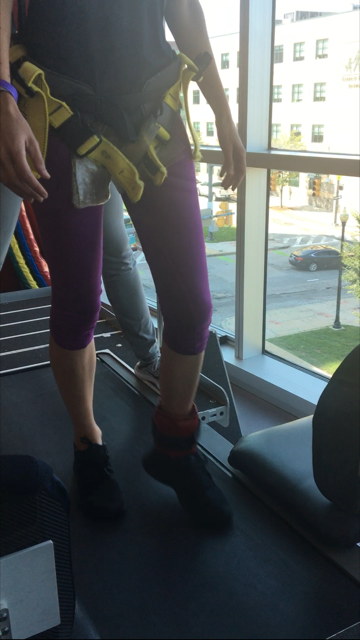I just got home from a full week of daily neurorehabilitation at the Kennedy Krieger Institute in Baltimore.
By the end of today, we managed to get my ankle to an active -10 degrees of dorsiflexion (Monday was -25) and passive to +17 (Monday was 0). Since ankle tightness is my major problem, we’re considering that a huge win. I have a home program now to work on to try to keep some of those gains. Sadly, with neurological conditions and especially spasticity, these types of gains tend to be temporary, but having a plan on how to achieve them at all is fantastic. I did improve it with my own tricks, but I wasn’t getting gains like I did today.
How’d we do it? First, I stood on the Galileo for 3 sets of 3 minutes, doing increasingly deep squats to stretch my calves while getting the spasticity to calm down from the oscillating vibration (seriously, this machine is magical, and it actually mediates the stretch reflex, which is hyperactive in spasticity). Then, I did a Mulligan mobilization technique that I had seen but hadn’t regularly done on myself. I did 10 reps of 5 seconds each rep. Next up, I did alternating functional electrical stimulation, working 1 second of plantar-flexion and 1 second of dorsiflexion, for 5 minutes. I placed my foot on a block to allow my foot to point down and see how high I could lift it up (I’ll be doing this on the reformer at home… because everything is better when you add the Pilates!)
After that, we measured my active (me trying to move my ankle) and passive (the PT pushing on my foot to flex my ankle) range of motion to get the measurements I listed above. On Monday, we had set the goal of the end of two weeks to hit 0 degrees of active dorsiflexion, so I’ll keep working at it daily on my own. I’ll head back to Kennedy Krieger in several weeks to get a round of botox to further loosen my calf muscles and then go into twice-weekly PT with them while the botox has weakened by calf muscles (weak is going to be easier to stretch than overly tight). This is a change of plans over where I started on Monday when I was going to be coming for two weeks straight. Botox takes about 3 weeks to take full effect, so I need to first, get the injections and second, start with slightly altered PT when it’s in my system.
We also discovered a bit of a mystery. I’ve realized over several years that I have a lot of difficulty doing open chain hamstring exercises with my left leg (think single leg kick). I always blamed this on quadricep spasticity. What Kristen (PT) discovered is that it’s actually not spasticity. My left quadricep doesn’t know that it needs to turn off to allow my hamstring to fire correctly. So, when I try to move my hamstring (like kicking towards my glutes), I feel a strange stuttered movement. Now that it was pointed out to me, I can actually see my vastus lateralis (quad muscle to the outside of the leg) twitching when I try to bend my knee (we are our own worst clients). This means that it’s actually a coordination issue, not a spasticity issue as I had suspected. Somewhere in my brain (likely in my cerebellum, near where I have some MS lesions), there are some crossed wires. Your cerebellum organizes movement in your body.
For those of you who have taken my workshops, we talk a lot about motor and sensory brain maps. I think that the quadricep and hamstring maps have overlapped, so now part of my physical therapy plan will be exercises to focus on differentiating them. This will involve using e-stim with exercises that move fairly rapidly from knee extension to knee flexion.
Finally, we did a ton of gait videos looking how my gait changed with different levels of orthotics. Some people in the Pilates world are anti-orthotics, but if you’re dealing with a lot of stability and tightness issues, it makes sense to try to have your ankle alignment be as good as possible. The winning orthotic was a very deep heel cup, which prevented my right (good side!) ankle from going from supination to a large pronation on each step.
Still no news on the DEXA scan, so I’ll blog about that when I get the results.
In health,
Mariska









